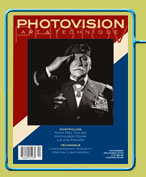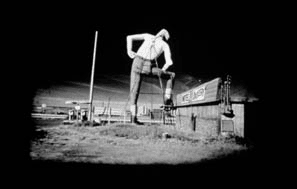| By: Robert Hirsch From Vol. 1 No. 1 In My Opinion |
|
We often assume that all pictures are “signs” that stand for something and possess an innate semiotic (pertaining to signs) structure and value. But is it also possible that pictures are just pictures that represent circumstances that cannot be expressed in any other way. Pictures possess their own native structure that may defy explanation regardless of how many words are wrapped around them. Most people who make photographs share the common bond of wanting to represent (commemorate) a likeness of something that is important in their life. Individuals make photographs because words often fail to adequately describe and express their relationship to the world. Pictures are an essential component of how humans observe, communicate, celebrate, and remember. For the majority of people the standard, automatic type of photographic record keeping is adequate, but for others it is not. This smaller group finds it a necessity to control, interact, and manipulate the photographic process and to interpret and actively interject their responses to the subject.
A photograph is not necessarily about something; rather it is something in and of itself. A photograph may be enigmatic or it may allow a viewer access to something remarkable that could not be perceived or understood in any other way. It is analogous to what the dancer Isadora Duncan said: “If I could explain to you what I meant there would be no reason to dance.”
Being involved in photography as an educator, curator, gallery director, and author, I have observed a reoccurring core group of questions that people ask regarding the imagemaking process. A thoughtful discussion surrounding issues of why people make photographs allows photographers to understand how the concepts and processes of photography have evolved and in turn place themselves in a more informed position to explore future possibilities. This column is the first in a planned series of columns of thirty questions and answers that are designed to encourage photographers to gain a larger overview of fundamental concepts, images, and issues that can inform their work. By thinking through this series, photographers can expand and deepen their vision and interests rather than following a current style or trend. The responses do not preclude other answers. They offer an initial pathway to form the basis of a discussion, to provoke, and in turn to help people formulate their own solutions. I encourage readers to respond to this initial column with their thoughts and questions to create an interactive dialogue around these issues.
1. Who is a photographer?
A photographer is a person who has decided to become and pursue the life of a photographer.
2. How does one become a photographer?
Looking at photographs can be a primary activity. Photographs are made from other photographs, as well as drawings, paintings, and prints. Look at what drives your curiosity. Look at the classics. They have been preserved because the patterns recorded in them have proved to be invariably useful over time. Look at contemporary work that is wrestling with new and different ways of expressing ideas. Read, study, and practice different methods of photography, not for the sake of technique, but to discover the means to articulate your ideas. Step back from the familiar to better understand it. One big peril facing photographers is lack of commitment that translates into indifference in their work. Talking, thinking, and writing about photography are vital components of understanding the process, but these activities do not make one a photographer. Ultimately, to be a photographer one must fully engage in the process and make photographs (usually lots of them).
3. What does a photographer do?
A photographer contemplates the nature of making photographs, the cerebral and emotional drive of working with a subject and process. Once this is accomplished the photographer can then act to provide a physical form in which time is manipulated and/or suspended to allow a subject to be thoughtfully examined.
4. Why is photography important to us as individuals and collectively as a society?
In 1999 a National Public Radio reporter asked Oklahoma tornado survivors what their most irreplaceable object was. One after another said that their snapshots were what they wanted to recover from their ruined homes as their other material possessions could be eventually replaced. This reveals the crux of why people photograph: to save and commemorate a subject of personal importance. The image may be a memory jog or an attempt to stop the ravages of nature and time. Regardless of motive, this act of commemoration and remembrance is the critical essence of both amateur and professional photographic practice.
What does this mean in terms of artistic practice at the beginning of a new century? There are more options than ever to pursue. Whether the images are found in the natural world, in a book, or on a screen, part of an imagemakers job is to be actively engaged in condition of “looking for something” How this act of looking at a subject is organized, its particular routines, uncertainties, astonishments, and quixotic complexities, are what make each photographer unique.
5. Why is it important to find an audience for your work?
Part of a serious photographersí job is to engage and stimulate thinking within the community of artists and their world at-large. Without an audience to open a dialogue the images remain incomplete and the artist unsatisfied.
6. What can images do that language can not do?
An accomplished photograph can communicate visual experiences that remain adamantly defiant to words. The French writer Albert Camus stated: “If we understood the enigmas of life there would be no need for art.” We know that words have the power to name the unnamable, but words also hold within them the disclosure of a consciousness beyond language. Photographs may also convey the sensation and emotional weight of the subject without being bound by its physical content. By controlling time and space photo-based images allow viewers to examine that which attracts us often for indescribable reasons. They may remind us how the quickly glimpsed, the half-remembered, and the partially understood images of our culture can tap into our memory and emotions and become part of a personal psychic landscape that makes up an integral component of identity and social order.
To be continued…
Robert Hirsch’s latest book Seizing the Light: A History of Photography is published by McGraw-Hill (www.mhhe.com/museum). Hirsch will be teaching an online history of photography course this January for college credit. For information visit www.enmu.edu/photohistory. Hirsch is also the author of Exploring Color Photography, third edition also published by McGraw-Hill and is currently working on a revised and expanded second edition of Photographic Possibilities: The Expressive Use of Ideas, Materials, and Processes published by Focal Press (www.focalpress.com). He is on the art faculty of the State University of New York at Buffalo and will be teaching History of Photography this fall. His photographs were most recently shown at Stefan Stux Gallery in New York. They are also featured in the current Light Work Annual/Contact Sheet 107 with an essay by Jeffrey Hoone, Director of Light Work, Syracuse, NY (www.lighwork.org).



